|
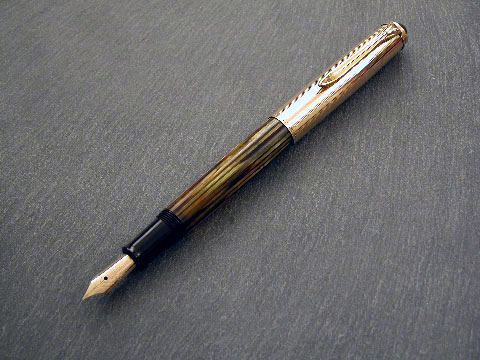
Pelikan 500NN Fountain Pen, late 1950’s
Ever since trading with a fellow Pentracer for a vintage 1956 Pelikan 400
in tortoiseshell stripe finish, I’ve had a hankering for one of the upmarket
versions of this fine classic pen, and recently had the good fortune to discover
something very similar for sale on the website of a British-based dealer.
The pen in question is a tortoiseshell Pelikan 500NN, which is the penultimate
development of the vintage Pelikan 400 series of the 1950’s and 60’s.
This is a scarce pen, and very desirable to collectors, something which is reflected
in the price today.
The original 400 series were in production from 1951 – 1956, and changed
only slightly with the introduction of the 400N (fractionally longer barrel, slightly
more curvaceous ‘ink handle’ or piston turning knob) in 1956 - which
had a production run of less than one year. The 500 variants incorporated a rolled
gold (gold-filled) cap and in some cases this gold covering was also added to
the ‘ink handle’, and in the 520 the entire pen. The 500’s were
also available with black-striped, green-striped or tortoiseshell brown-striped
barrels, with brown knob and section on the latter.
The ‘NN’ pens, which were introduced in 1956 and produced until
1965, have a more streamlined, ‘torpedo-shaped’ profile than the earlier
400 series pens and their revived descendant the M400. As you can see from the
photographs accompanying this review, the body and section are much the same,
but the piston turning knob or ‘ink handle’ is more curved and distinctly
conical. The ‘torpedo-taper’ is also reflected in the redesigned cap,
finished in rolled gold in the case of the 500NN, which curves to an embossed
conical logo-disc or ‘jewel’, in a style reminiscent of the ubiquitous
Parker “51”, and this suggests an interesting marketing ploy.
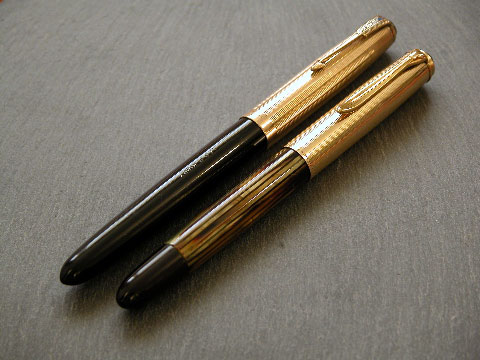
Parker “51” Vacumatic (rear)
and Pelikan 500NN, capped
In fact, comparing the Pelikan 500NN directly to the Parker “51”,
it is possible to see how the Pelikan may conceivably have evolved its more curvaceous
and fashionable later form in the NN series to meet the futuristic and influential
styling of the very competitive “51” series, without losing its own
inimitable ‘Pelikanness’.
Putting the tortoiseshell celluloid-striped and rolled gold 500NN up against
my black Lucite and gold-filled 1940’s 51 makes the similarities obvious,
especially capped, when the resemblance is startling. The cap of the Pelikan is
perhaps an eighth-inch shorter than that of the Parker, including both cap ‘jewels’,
and overall we are looking at around a third-inch difference in capped length,
with the Parker being the longer of the two. Apart from the difference in barrel
colour in this case, they look very similar indeed, and a black-barrelled 500NN
would be a dead ringer for a “51” from a distance, especially in a
shirt pocket. The cap of the 500NN is threaded to match the barrel, and the Parker
51 cap uses a push-fit finger and clutch ring system – both work well. Capped
and filled, my 500NN weighs 19.9g; my gold-capped 51 vac-filler 21.4g.
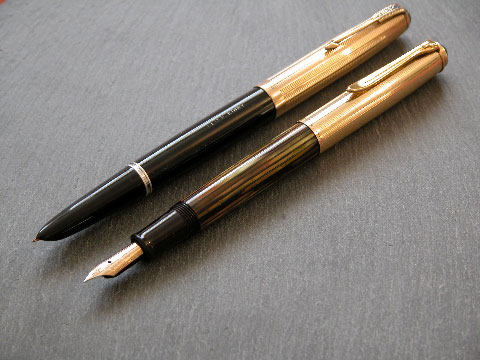
Parker 51 and Pelikan 500NN, uncapped
and ready for action!
Of course, uncapped, the two pens become very different beasts, technically.
The Pelikan, despite its curvy filling knob, still uses the same tried and tested
Pelikan piston-filler as the 400 and 100 series, and beneath its equally curvy
blind cap lurks the Parker’s well-established vacumatic pump-filler. Later
versions of the now sadly long-defunct “51” simplified operation with
the aerometric filler, but Pelikan of course still uses their ‘old faithful’
piston-filler in the majority of their pens even today. Sadly, the modern Parker
51 Special Edition abandoned most of the crucial design elements of its illustrious
ancestors and there is still much debate about whether it is a real “51”
or not.
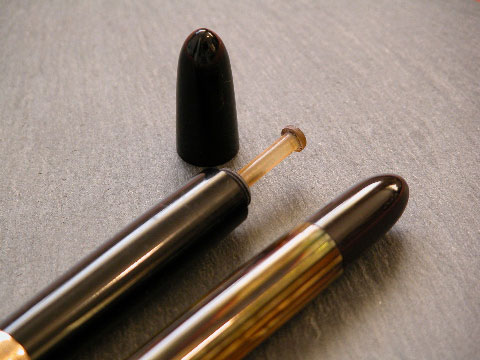
Parker 51 vac-filler with blind cap
removed, Pelikan 500NN ‘ink handle’ at front
I have to say that, despite owning many other types of pens with different
filling systems, I remain a big fan of the precise and reliable Pelikan piston-filler,
especially in conjunction with the translucent barrels which so many sport, enabling
a fair idea of the ink remaining to be judged. While I see the vacumatic “51”
as an undeniable classic pen, way ahead of its time, I also feel the inability
to judge its ink level is a definite minus – unless of course you have the
demonstrator! The reliance of the 51 ‘vacuum pump’ vacumatic filling
system on a perishable rubber diaphragm is also cause for long-term concern, though
in practice these may be replaced by skilled professional or hobbyist pen-repairers
easily enough. The Pelikan piston-fillers use neither diaphragm nor sac, filling
a section of the barrel itself by means of a vacuum created by a twist-plunger.
There can be no doubt that the Pelikan filler is more positive and robust in use
than the vacumatic system, though a case could be made for the later, mechanically
simpler Parker aerometric ‘squeeze’ filler, but of course with those
you have to remove the Parker pen barrel to fill and to check ink level –
another minus in comparison. On the other hand, the Pelikan piston takes up space,
reducing ink holding capacity compared with the Parker.
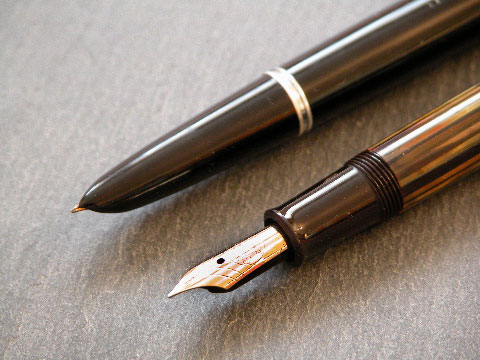
Close-up of the legendary Parker 51
‘hooded’ nib (rear) and the traditional Pelikan 14ct gold ‘open’
nib
Apart from filling, of course, the primary difference between these two pens
– and a distinctive element of their character in use – are their
nibs. The Pelikan, as today, using the traditional open nib and ebonite feed,
and the Parker its ground-breaking hooded nib and collector system. It is the
nature of Pelikans of this period to have semi-flexible nibs, and the 51’s
to have a very rigid nib, the result of its very strong, cylindrical design hidden
away in a tiny space under the hood!
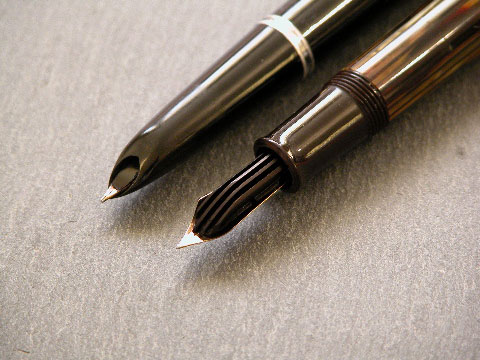
A hint of the hooded nib and collector
system of the Parker 51 (rear) and the longitudinal ebonite feed of the classic
vintage Pelikan
The fine nibs on these Parkers tend to be very fine indeed, and very precise
writers. Such is the case with my “51” – it’s a great
pen for fine note-taking and journaling, and the firm nib is the kind of thing
a ballpoint writer would find it easy to change over to. The Pelikan on the other
hand is much more flexible – though I have to say the fine nib on this later
500NN is by no means as flexible as the oblique fine on my 1956 vintage 400, and
you can perhaps see the development towards the current springy but not truly
flexible modern Pelikan nibs in this.
In writing, these two nibs are equal for smoothness, with some tooth on certain
papers which is to be expected from such fine nibs. The feedback given by the
Pelikan nib does, in my mind, offer the more pleasurable writing experience, but
that is perhaps more a matter of taste. In practice, the Parker tends to be a
dry writer, the ebonite feed on the 500NN giving consistently greater flow, but
of course any adjustments which might be made might easily cancel out these differences.
The Parker 51 is certainly very different in character, and the change in ‘feel’
from one pen to the other is very obvious.
One final difference which will be a clincher for many fountain pen users
seeking versatility is of course the user-interchangeable nib system of the 400
and 500 series Pelikans, which are fully compatible, and are still compatible
with modern Pelikans such as the M200, M250, M400 and early M600’s and their
variants. A wide range of both vintage and modern nibs is available for all these,
in gold or steel. The Parker “51” does not measure up in this regard,
having no interchangeable nibs and with pens being relatively scarce with nibs
broader than medium.
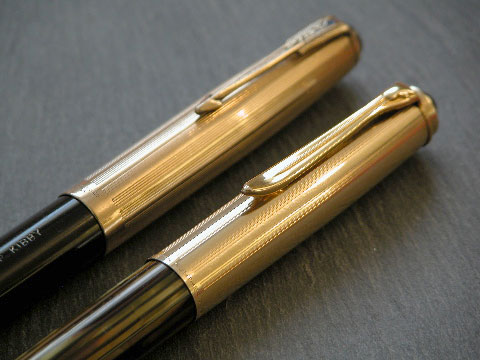
The oh-so-similar caps of these two
classic pens
At the end of the day, despite the obvious visual similarities, these are
two very different pens, both excellent within their design parameters but operating
in very different ways and with different ‘feels’. Is one better than
the other? How long is a piece of string? It would be better to say “what
are your writing needs” and chose accordingly. The Pelikan 500NN for its
classic and for the moment future-proof German design, and its calligraphic versatility
and flair; the Parker 51 for its hard-nosed, ahead-of-its time space-age purity
as a limited but highly efficient writing instrument.
One final note. You will not find it easy to acquire a Pelikan 500NN, they
are sought after and they are not cheap. I paid a fair price of £200 UK
Pounds ( $300 US ) for mine, in truly excellent condition. The only other ones
I have seen for sale on the Internet so far are £500 ( $750 US ) and above,
though I’m assured that $350 - $450 US is a more typical ‘street’
price such as may occasionally be found on Ebay. The Parker “51”,
on the other hand, is typically much cheaper and easy to find in the more common
colours and cap combinations. I paid just £80 ( $120 US ) for my gold and
black “51” with its matching mechanical pencil – though you
will pay a lot more for the highly collectable early versions with double jewels
and scarcer colours.
You pays your money, and you takes your choice. Personally, I love ‘em
both, but if pushed it would be the Pelikan 500NN in tortoiseshell that I would
hang onto.
Stuart Williams
Bloxwich, England
Text and Photos © 2003 Stuart Williams.
|